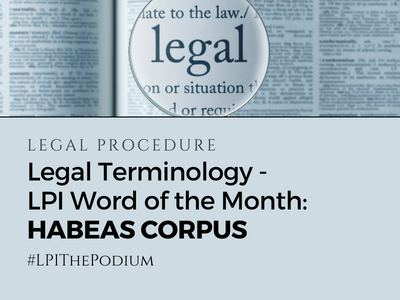
HABEAS CORPUS
Habeas corpus is Latin for “that you have the body.” Federal courts can use the writ of habeas corpus to determine if a state’s detention of a prisoner is valid. A writ of habeas corpus is used to bring a prisoner or other detainee (e.g. institutionalized mental patient) before the court to determine if the person’s imprisonment or detention is lawful. A habeas petition proceeds as a civil action against the State agent (usually the warden of a correctional facility) who holds the defendant in custody. It can also be used to examine any extradition processes used, the amount of bail, and the jurisdiction of the court.
The habeas corpus process first originated back in 1215, through the 39th clause of the Magna Carta signed by King John, which provided “No man shall be arrested or imprisoned…except by the lawful judgment of his peers and by the law of the land.” English courts began actively considering petitions for habeas corpus in 1600. While habeas corpus had initially originated as an instrument in opposition to the king’s “divine right to incarcerate people,” there were many other constables and other authorities during those times, who imprisoned people for various reasons. Accordingly, habeas corpus also developed as the king’s role to demand account for his subject who is restrained of his liberty by other authorities.
The law of habeas corpus was adopted in the U.S. as well. James Madison, in 1789, argued for the adoption of the Bill of Rights, including Habeas Corpus. The fourth Chief Justice of the U.S. Supreme Court, Chief Justice Marshall, emphasized the importance of habeas corpus, writing in his decision in 1830, that the “great object” of the writ of habeas corpus “is the liberation of those who may be imprisoned without sufficient cause.” The U.S. Supreme Court recognized the writ of habeas corpus as “the fundamental instrument for safeguarding individual freedom against arbitrary and lawless state action” and must be “administered with the initiative and flexibility essential to ensure that miscarriages of justice within its reach are surfaced and corrected.
HABEAS CORPUS IN THE U.S. TODAY
The sources of habeas corpus can be found in the Constitution, statutory law, and case law. Although the Constitution does not specifically create the right to habeas corpus relief, federal statutes provide federal courts with the authority to grant it to state prisoners. Only Congress has the power to suspend the writ of habeas corpus.
In 1789, Congress explicitly authorized the federal courts to grant habeas relief to federal prisoners. Congress expanded the writ following the Civil War, allowing for habeas relief to state prisoners if they were held in custody in violation of federal law. Federal courts granted habeas relief to state prisoners by finding that the state court lacked the proper jurisdiction. Post-World War II reforms further expanded the writ: through the incorporation process by which the Bill of Rights was applied to the states, habeas corpus became a tool by which criminal defendants sought to uphold their civil rights against illegal state action. The Warren Court further paved the way for broader habeas corpus rights.
Today, habeas corpus is mainly used as a post-conviction remedy for state or federal prisoners who challenge the legality of the application of federal laws that were used in the judicial proceedings that resulted in their detention. Other uses of habeas corpus include immigration or deportation cases and matters concerning military detentions, court proceedings before military commissions, and convictions in military court. Finally, habeas corpus is used to determine preliminary matters in criminal cases, such as: (i) an adequate basis for detention; (ii) removal to another federal district court; (iii) the denial of bail or parole; (iv) a claim of double jeopardy; (v) the failure to provide for a speedy trial or hearing; or (vi) the legality of extradition to a foreign country.
Categorized in: Legal Procedure
| << previous | next >> |








